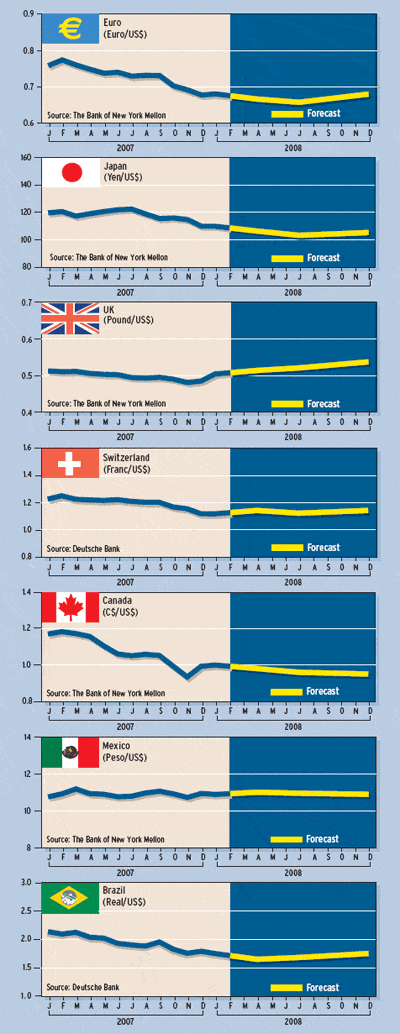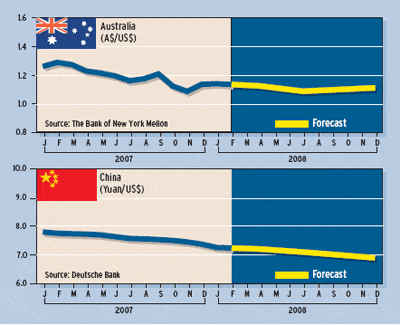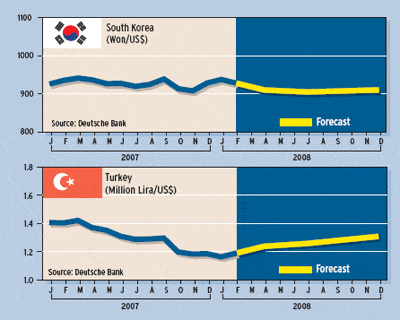With the US economy nearing a recession, if it hasn’t already entered one, the Federal Reserve will continue cutting interest rates in the months ahead, likely leading to further losses in the already beat-up dollar, analysts say.
The dollar should fall against most major currencies in the first half of 2008, as the United States leads the global slowdown and the Fed eases, says Gabriel de Kock, Citi’s chief currency economist in New York. “But the global credit crisis poses hurdles for economic activity in many countries outside the US, creating scope for a dollar recovery in the second half of 2008,” he adds.
The euro, which gained about 12% against the dollar in 2007, is expected to appreciate further in the first half of this year but to lose ground later in the year, when the European Central Bank is expected to respond to tighter financial conditions, the Citi economist says.
 The bank’s forecast for continued growth in emerging markets points to faster currency adjustment in many developing countries, but this depends critically on further monetary policy easing from the major industrialized economies to lessen risks of a global slowdown, de Kock says. There are closer economic ties between emerging markets and industrialized countries than ever before, he notes.
The bank’s forecast for continued growth in emerging markets points to faster currency adjustment in many developing countries, but this depends critically on further monetary policy easing from the major industrialized economies to lessen risks of a global slowdown, de Kock says. There are closer economic ties between emerging markets and industrialized countries than ever before, he notes.
De Kock notes that “2007 will be remembered for the severe credit crunch triggered by the subprime meltdown, the sharp second-half spike in market volatility from historic lows and for the steepest broad dollar decline since 2003.” He adds: “We expect the dollar to overshoot to the downside against most Group of 10 currencies in the first half of 2008, as the US economy and markets weaken further.”
Outside the US, the impact of the liquidity and credit crunch appears most acute in the United Kingdom, where further monetary policy easing is expected to counter a sharp housing correction, consumer retrenchment and slower corporate expansion, de Kock says. The British pound has been the weakest major currency against the dollar in recent months, dropping from $2.11 early last November to an eight-month low of $1.95 in mid-January and to a record low against the euro.
“We may as well name the pound as the ‘dollar of 2008,’ as it faces ample downside room,” says Ashraf Laidi, chief foreign exchange analyst at CMC Markets US in New York. “We expect more losses for the pound, as the Bank of England is seen cutting rates throughout this year,” he says. Weakness in the pound will be a major theme in currencies for 2008, which should help the dollar to obtain some stability, he predicts.
The Bank of England lowered interest rates to 5.5% in December 2007, its first cut since August 2005. While the UK central bank stood pat on rates in January, Barclays Capital economists expect another cut this month. “We think there is a risk the Bank of England may cut rates faster than is currently priced into the markets,” says Paul Robinson, chief sterling strategist at Barclays Capital in London. There is a downbeat mood surrounding the UK economy, and if consumers and businesses become more pessimistic about prospects, the economy is almost certain to slow because spending will likely slow, he adds.
Britain’s record trade deficit has also helped push down the value of the pound, while ECB president Jean-Claude Trichet’s recent remarks indicating that he was more worried about inflation than economic growth have boosted the euro.
“For now, strong eurozone inflation and money-supply data will keep the ECB in a hawkish mode, though we think it will be near impossible for the ECB to hike rates this year,” says Marc Chandler, global head of currency strategy at Brown Brothers Harriman, based in New York. “We stress that just because the calendar year changed does not mean that markets are starting with a clean slate,” he adds. “The negative factors for the dollar that prevailed in 2007 remain in play, and further dollar weakness is likely in the first quarter of 2008,” he says. “However, we continue to believe that the dollar can stage a recovery as the year progresses.”
 The US economy will survive the financial market crisis, and the US will be rewarded for its pro-growth policies in 2008, the Fed having begun its rate-cutting cycle well ahead of other central banks, Chandler says. Rate cuts by the Bank of England and the Bank of Canada have already begun to weigh on the British pound and the Canadian dollar, he says. “As the market begins to anticipate cuts by the ECB, the euro will also begin a downtrend in the first half of 2008,” according to Chandler.
The US economy will survive the financial market crisis, and the US will be rewarded for its pro-growth policies in 2008, the Fed having begun its rate-cutting cycle well ahead of other central banks, Chandler says. Rate cuts by the Bank of England and the Bank of Canada have already begun to weigh on the British pound and the Canadian dollar, he says. “As the market begins to anticipate cuts by the ECB, the euro will also begin a downtrend in the first half of 2008,” according to Chandler.
Just as the euro did not sustain its upside momentum after the weak US jobs report for December, it again struggled to move higher on January 10, following hawkish remarks from Trichet, who clearly identified anchoring inflation expectations as his top priority, notes Chandler.
 The ECB kept its benchmark interest rate unchanged at 4% in January, in line with market expectations. While there was no indication of an imminent rate hike, it is clear that the ECB is prepared to raise rates as soon as this month, says Michael Woolfolk, senior currency strategist at The Bank of New York Mellon. “The takeaway from Trichet’s press conference is that the ECB is prepared to raise rates if second-round effects from recent spikes in energy and food prices begin to emerge,” he says. What’s more, Trichet implied that the ECB Governing Council did not even discuss the possibility of a rate cut in January’s meeting, he adds.
The ECB kept its benchmark interest rate unchanged at 4% in January, in line with market expectations. While there was no indication of an imminent rate hike, it is clear that the ECB is prepared to raise rates as soon as this month, says Michael Woolfolk, senior currency strategist at The Bank of New York Mellon. “The takeaway from Trichet’s press conference is that the ECB is prepared to raise rates if second-round effects from recent spikes in energy and food prices begin to emerge,” he says. What’s more, Trichet implied that the ECB Governing Council did not even discuss the possibility of a rate cut in January’s meeting, he adds.
In 2007, when the ECB raised interest rates by 50 basis points while the Fed cut rates by 100 basis points, there is no wonder why the euro reached a record high of nearly $1.50, says Kathy Lien, chief strategist at Forex Capital Markets (FXCM), a provider of online currency trading services. “Interest rates are the primary driver of currency market fluctuations, and that will remain the case in 2008,” she says. Even if the ECB is unable to ease rates, if it shifts its policy from hawkish to neutral, that may be enough to trigger a recovery in the dollar in the second half of this year, she says.
If the ECB begins to cut interest rates as well, it would mark a significant shift in monetary policy, which in turn could result in a major shift to the outlook for the euro, Lien says.
Gordon Platt



